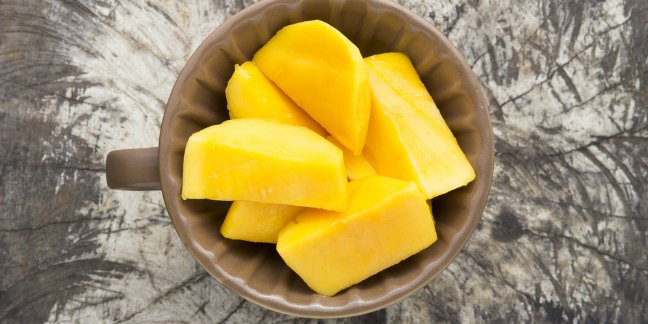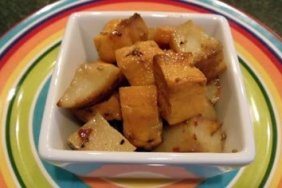The Goodness of Mangos for Baby:
Mangos are loaded with Vitamin A and contain a higher level of carotenoids than almost any other fruit. These carotenoids are said to reduce the risk of cancer as well as heart disease. Carotenoids are also thought to be successful in warding off the common cold.
Mangoes are low in fat, low in calories but very high in fiber. You will also find lots of Vitamins C and B in Mangoes as well as iron, potassium and protein.
When Can Baby Have Mango? Age for Introducing Mango 6-8 Months 
Like Papayas, Mangos are tropical fruits and their age for introduction is varied from 6 months and older to 8-10 months being the average recommended age. While mangos may make a great first food, they are probably not good to use as THE first food.
MANGO (one cup – sliced) |
|
| VITAMINS:Vitamin A – 1262 IU
Vitamin C – 45.7 mg Vitamin K – 6.9 mg Vitamin E – 1.85 mg Folate (important during pregnancy) – 23 mcg |
MINERALS:Potassium – 257 mg
Phosphorus – 18 mg Magnesium – 22 mg Calcium – 16 mg Sodium – 3 mg Also contains trace amounts of zinc, iron, manganese and copper. |
Are Mangos Allergenic?
Mangos may be allergenic as many tropical fruits often tend to be. They are not know to commonly cause life threatening allergic reactions however. The type of allergic reaction a Mango may cause is typically topical or dermatological.
A person who has an atopic reaction to Mango will find a rash much like that of poison ivy or poison oak. The rash may occur when the affected person comes into contact with either the sap from the Mango tree or from the skin of the fruit itself.
The allergen itself resides in the skin/peel of the mango and not within the actual fruit itself. Eating the mango “meat” or pulp will not cause the rash to get into the throat or tummy per se but if the oleoresin from the peel/skin has touched the Mango “meat”, a rash may erupt around the mouth.
Some sources say that a Mango allergy may in fact cause a rash around the bottom as the mango is digested and passed through. That being said, there are many pediatricians who say that tropical fruits should be held off until 8 months old and up. To learn more about Mango Allergies, read this 2011 study.
In January of 2012, Deb submitted this comment to the Wholesome Baby Food Facebook Fan page:
I love the content on your site – such a valuable resource! I do need to point out a claim about the allergen nature of mangoes that I don’t believe to be correct. Your website states, “Mangos may be allergenic as many tropical fruits often tend to be. They are not know to commonly cause life threatening allergic reactions however. The type of allergic reaction a Mango may cause is topical or dermatological.
Mangoes are in the same plant family as cashews, pistachios, poison ivy, poison oak, and poison sumac. People with allergies to cashews, pistachios, poison ivy, etc can have allergic reactions to mangoes. This reaction can be as severe as anaphylaxis. My husband has anaphylactic reactions to mangoes, pistachios, and cashews. Of course, everyone should consult their pediatrician. But parents with allergies to cashews and/or pistachios might want to seriously consider (and discuss with doctor) if mangoes are an appropriate food for baby.
Anaphylaxis due to mango allergy is not common and continues to be rare. Mangos are not considered highly allergenic however as Deb notes, it is prudent to consider your family history and to consult with your pediatrician if you have a history of other nut allergies or severe reactions to poison ivy/oak. Remember that all foods have the potential to be allergenic.
Choosing and Storing Mangoes
 According to the EWG, mangos are not one of the “dirty dozen” foods that are most highly contaminated with pesticides – purchasing organic is a personal choice.
According to the EWG, mangos are not one of the “dirty dozen” foods that are most highly contaminated with pesticides – purchasing organic is a personal choice.
When selecting mangoes, give the fruit a gentle push with your thumb. The fruit should be slightly soft and a bit fragrant. Mangoes can be green or reddish orange and even golden-yellow-orange in color. The skin should have a uniform color and show no signs of bruising or have little brown dots on it. Mangoes may be ripened at home on your counter.
Does Mango Need to be Cooked for Baby?
When introducing mango to baby, you should not need to cook (steam) it if it is ripe and soft. If your baby is younger than 8 months old when you decide to introduce mango, you may wish to steam it gently to help break it down.
How to Cut A Mango:
Cut the mango lengthwise, along the side of the mango pit. You will be cutting off its flesh from one side then repeating the same process on the other side. You will then cut the ends off the mango pit.
Cut the remaining flesh from the pit. Use a small sharp knife peel the skin from the flesh. Dice or cube as desired. It is easier to make your cubes/dices prior to removing the skin. Make sure you don’t cut through it. Once you have made your cube/dice “pattern” simply turn the skin skin inside out and slice the pieces away.
Mango Baby Food – Basic Recipes
Mango Puree
Ingredients:
- 1 Ripe Mango
Directions:
Step 1: Peel, Deseed and mash the mango until smooth.
Step 2: Add water if needed until the proper consistency for your baby is achieved.
Creamy Mango Puree** 
Ingredients:
- 1 Ripe Mango
- Plain or Vanilla Yogurt OR
- Apple or Pear Juice or plain water
Directions:
Step 1: Peel, Deseed and Mash Mango until smooth.
Step 2: Add yogurt (or juice or water) until the proper consistency for your baby is achieved.
** If your infant is currently not eating yogurt and/or you do not wish to use any juice, simply peel, deseed and mash the mango the proper consistency for your Infant – with or without water.
Mixed Mango Tango
Ingredients:
- 1/2 cup mashed mango
- 1/2 ripe banana – peeled and mashed
- 1 ripe peach – pitted and mashed (remove skin)
Directions:
Step 1: Add fruits to a large bowl and mash together
Step 2: Add water or another liquid if your baby needs a thin consistency.
Step 3: Serve as is or mix into baby’s cereal or other grain.
This mix goes well with chicken or pork.
Foods Good to Mix With Mangos:
- Mangoes Online
- About Mangoes
- Transitioning to Sippy Cups
- Introducing Finger Foods to Baby
- My Baby Refuses the Spoon – Help.
- Constipation and Solid Foods
![]() Remember, always consult with your pediatrician regarding introducing solid foods to your baby and specifically discuss any foods that may pose allergy risks for your baby.
Remember, always consult with your pediatrician regarding introducing solid foods to your baby and specifically discuss any foods that may pose allergy risks for your baby.
ORAL ALLERGY SYNDROME
Birch Pollen Allergies
Birch pollen allergies are associated with apple, carrot, cherry, mango, pear, peach, plum, fennel, walnut, potato, spinach, buckwheat, peanut, honey, celery, and kiwifruit.
Cedar Allergies
Japanese cedar allergies are associated with melon, apple, peach and kiwifruit.
Mugwort Allergies
Mugwort allergies are associated with celery, carrot, spices, mango, melon, watermelon, apple, hazelnut, and chestnut.
Grass Pollen
Grass pollen allergies are associated with melon, tomato, watermelon, orange, rice and cherry.
Ragweed Pollen
Ragweed allergies are associated with melon, chamomile, honey, banana, and sunflower seeds.
Latex
Latex allergies may be cross-reactive to banana, avocado, kiwi and papaya. Mango is possible though less common.
Mangos are tasty fruits to add some tropical flare to your baby’s diet. High in fiber, mangos may help keep baby regular.


